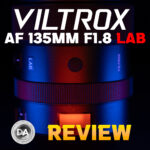
Viltrox AF 28mm F4.5 Review
Viltrox is clearly a very ambitious company. I’ve had the unique opportunity to start from the beginning with them, reviewing their first 20mm F1.8 manual focus lens in early 2019. Then came an 85mm F1.8 manual focus, then their first autofocus lens right after that (also an 85mm F1.8). They spent a few years honing their craft with fairly standard “series” lenses (23mm, 33mm, and 56mm F1.4 APS-C lenses, then 35, 50mm, and 50mm F1.8 full frame lenses). But I first noticed them start to break out with a more ambitious lens in the form of the 13mm F1.4 APS-C lens, and then came the standout Pro series (27mm and 75mm F1.2 for APS-C) and the amazing 16mm F1.8 full frame lens, which was their first premium full frame lens. They have now diversified into their high performing yet lightweight “Air” series (20mm F2.8, 40mm F2.5, and 56mm F1.7) while also prepping the launch of the ultra high performance LAB series. Ambitious indeed. But part of what makes Viltrox unique is that they are simultaneously tackling both the high end of the market (LAB and PRO series) while also addressing the extreme budget end of the spectrum (AIR series). Nothing illustrates that better than their next two lens releases – the ultra high performance LAB 135mm F1.8 VCM and their cheapest lens yet – the Viltrox AF 28mm F4.5 VCM micr-pancake lens that they have nicknamed “the Chip” (as in ‘as thin as a potato chip’. And at just 15.3mm in length, this is the second thinnest lens I’ve ever reviewed, and easily the thinnest autofocusing lens that I’ve ever tested. And at a price tag of just $99 USD, it’s a lens that anyone can afford. But is this tiny little thing worth buying? Find out in the video review or just read on in the text review.
Follow Me @ YouTube | Patreon | Instagram | Facebook | DA Merchandise | Flickr | 500px | X
Thanks to Viltrox for sending me a review copy of this lens. As always, this is a completely independent review. *The tests and most of the photos that I share as a part of my review cycle have been done with the Sony a7RV and the Sony Alpha 1.
__________________________________________________________________________________________________
This a very different kind of lens for Viltrox, as producing a lens this thin means that there are some things that will have to be compromised. For many such lenses, what gets sacrificed is image quality along with functionality. While the functionality is a little different here, fortunately the image quality is not.

But at the least, the functionality is different. This is the first “fixed aperture” lens for Viltrox, in that the 28mm Chip is always F4.5. Not bigger, not smaller. No aperture ring or aperture control from within camera. Aperture is fixed at F4.5.

There also isn’t any manual focus here. Whereas the only smaller lens that I’ve ever reviewed was manual focus only (the Brightin Star 28mm F2.8), the Viltrox 28mm Chip is autofocus only. There is no manual focus ring. Fortunately autofocus is good enough that you probably won’t miss it, and, frankly, the lens is so compact that there just isn’t room for any rings on the barrel.

So let’s dive a little deeper into the nuts and bolts of this extremely unique new lens.
Viltrox 28mm Chip Build and Handling
28mm is a focal length that was very popular during the film era, was largely forgotten during DSLR era, and has been experiencing a bit of renaissance in the past two years. It’s a fun focal length as a general walkaround lens, and that’s doubly true with such a tiny lens like this.
While this lens is very small and lightweight, it isn’t because of compromised build quality. This is actually a very nicely made little lens with a retro/classic vibe to it. The closest analog that I can come up with is Nikon’s SE (Special Edition) versions of their 28mm F2.8 and 40mm F2 Z mount lenses.

The interesting thing about the photo above (supplied by Viltrox) is that the slim Sony rear cap is almost as thick as the lens itself. Here’s a closer look at how close the two pieces are:

As I don’t have any of Sony’s smallest full frame cameras on hand right now (I’m doing this review on the larger a7RV and Alpha 1 cameras), I’ll borrow one more photo from Viltrox to show the 28mm Chip mounted on the compact a7C camera:

The actual dimensions are 60.3mm in diameter (2.37″) and just 15.3mm in length (0.60″). The weight is a minimal 60g (2.11oz). This may be the easiest lens to bring along on Sony E-mount that has yet been released, as it won’t take up much more room in your bag than the front camera cap.

The mount is metal (made of duralumin, an aluminum alloy). The body is also made of metals and feels different from something like brass, but surprisingly premium for such an inexpensive lens. Viltrox has been able to maintain their standard of having a USB-C port in the mount to allow for firmware updates, however.


You’ll note that there is a small lever on the front of the lens. That essentially serves like a front lens cap. One direction will open the protective cover over the glass elements for shooting, the other direct will close it and protect things for storage.
There are no other “features” on the lens. No switches (autofocus only), aperture ring (fixed aperture), or other buttons. This is the ultimate grab and go lens.

The fixed aperture makes it unique. F4.5 is neither fast nor slow, and that’s kind of the point. The hope is that F4.5 is “fast enough” that it doesn’t penalize too much in low light, but also provides enough depth of field to keep enough in focus at one time as you don’t have the option to close the aperture further. I think of this more as a street/general purpose lens than a portrait lens for that reason, as depth of field will almost never be small enough to give you real subject separation.

As far as handling, the truth of the matter is that the only thing you need to handle is the lever to open or close the protective cover. The lens is small enough that you might not even touch it during operation and instead keep your hands on the camera instead.
The only other thing to really discuss here is the minimum focus distance, which is 32cm. That’s not particularly impressive, though it does best the Viltrox AF 28mm F1.8, which can only focus as closely as 37cm. That gives a very slightly magnification advantage to the 28mm Chip at 0.11x vs the 0.10x of the F1.8 lens. Here’s what that magnification looks like:

Remember that the aperture isn’t particularly large, so don’t expect backgrounds to be blurred too much at minimum focus distances. Here’s a real world example:

While there is no weather sealing here, the front element has been treated with an HD nano multilayer coating that is moisture and fingerprint resistant.
People have been waiting a long time for an autofocusing pancake lens on Sony, and the fact that one hadn’t yet arrived had led to the rumor that the E-mount diameter just wouldn’t allow it. Viltrox has shot down that rumor just as Sigma put to bed the idea that an F1.2 full frame lens on E-mount was impossible. It’s great to see more innovation from Viltrox. Oh, and by the way, here’s the comparison between their two upcoming lenses (this one and the 135mm LAB). There’s a bit of size difference for you.

Autofocus and Video
The 28mm Chip is the first Viltrox lens (along with their upcoming 135mm F1.8 LAB lens) to receive a brand new autofocus system – VCM (voice-coil motor). This is similar to Tamron’s VXD focus system in being a linear style motor. It’s extremely unusual for there to be autofocus in a lens this thin, so the focus motor had to prioritize being extremely miniaturized. There’s clearly a difference between this focus motor and the dual “Hyper VCM” focus motors in the LAB 135mm lens, as that lens focuses with the speed of a GM lens, which the 28mm Chip is a bit more leisurely. Focus changes for most things are quick enough for you to forget about autofocus, but every now and then when a major focus change is required you are reminded that this is an autofocus motor that could use a little extra thrust. Fortunately accuracy isn’t a problem; I got consistently well focused results.

This is, of course, an autofocus only lens, so it is fortunate that autofocus is accurate.

Likewise with this shot, which I took during my tests of eye detection, shows that autofocus stayed properly locked on the eye even when I had a lot of foreground obstructions in the way.

In a dimly lit restaurant I was able to focus quickly and easily on a singer doing music even though there was no stage lighting on him.

There is a faint clicking/whirring sound if you put your ear right next to the lens barrel, but if I held the camera at chest level and racked focus here and there, I couldn’t hear anything. Focus speed was good but not instantaneous in my formal tests. There is a somewhat false impression that major focus changes are slower than they actually are due to some fairly strong focus breathing.
On the video side of things, focus pulls are smooth and have a somewhat cinematic “damping” to them, in that they are not abrupt and move smoothly from one subject to another. The advantage of the VCM over an STM is shown in the absence of any visible steps in the process. There is some very obvious focus breathing, however, so that makes things slightly less cinematic. I did find that in my focus pull tests that autofocus wasn’t always “nailed” on my foreground subject. It was sometimes lightly off.
My “hand test” where I alternately block the camera’s view of my face with my hand and then remove it went fairly well. The 28mm Chip was reasonably reactive in moving back and forth when appropriate, though the obvious focus breathing made that process a little more jarring than it needed to be.
On a side note, I did notice that my handheld results for video were a little shakier than usual. Having almost no weight at the front the camera actually makes stabilizing it a little tougher.
The strengths of the VCM motor here are in the smoothness and lack of steps. Focus speed is about average, and focus breathing is higher than average. This probably has to do with the tiny size of the lens and the fact that there isn’t much space for the focus elements to go. Still, there was the notion that an autofocus pancake lens couldn’t be done on E-mount, but here we actually have a micro-pancake lens that focuses just fine. That’s impressive!
Image Quality Breakdown
The optical formula is 6 elements in 6 groups (no grouping of elements), with 4 of those elements being special elements (including 2 ED and 2 aspherical elements). The MTF chart shows a good (not great) center performance, good midframe results, and then much softer corners.

The Viltrox AF 28mm F4.5 VCM is a very interesting lens optically. In many ways the optical performance reminds me a bit of a vintage lens. It’s as if it doesn’t have modern lens coatings, and that is for good and bad. I’ve rarely reviewed a modern lens where the “look” of the images is more dependent on the shooting situations and how you use it. This is true of contrast, detail, and more. The biggest single factor is going to be light: it’s direction, intensity, and placement in (or out) of the frame.

If I shoot towards the source of light, it will often produce a lower contrast look with almost a “halation” type glow to it, like here:

But all I had to do was turn the opposite direction and shoot, and you can see that there is more contrast, no glow, and the result is a more modern/conventional look.

If you are a fan of a warm glow to your images, then you may just fall in love with the look of images from the 28mm Chip:

More on this in a moment. Let’s look at the technical side of things.
Lenses with smaller maximum apertures rarely have an issue with LoCA (longitudinal chromatic aberrations), and that is the case here. I see mostly neutral results on either side of the plane of focus without any fringing.

There is, however, some issue with LaCA (lateral chromatic aberrations) that typically show up along the edges of the frame with high contrast transition points. You can see some obviously fringing as we get near the edge of the frame.

As the example above suggests, these LaCA issues tend to be reserved for the extreme corners. Here’s a real world example that shows no issue in the crop from further down the edge of the image (#2) and shows the actually fringing reserved for the extreme corner (#3):



If we move on to vignette and distortion we find reasonably good results. Distortion is essentially a non-issue, with just a tiny amount of distortion that is mostly not worth correcting (I liked a -1 result the best in Lightroom). Vignette is a fairly heavy, however, at a +77 to correct. It’s not surprising that there is a vignette in such a small optic.

We’ll move on to inspecting our test chart. This test has been done on a 61MP Sony a7RV sensor. I use a high end tripod and two second camera delay to ensure vibration doesn’t affect images. Here’s a look at the test chart that we will examine at high magnification:

If we take a look at crops (at 200%) at F4.5 from the center, mid-frame, and lower right corner, we find that center performance is good but slightly low contrast, with good detail but lower contrast in the mid-frame, while the corners are reasonably good until the extreme edge, where acutance really drops and the details become mushy.



What I found out in real world shooting was that my impressions of sharpness really varied from image to image. In this country landscape, detail in the center looks good (though with a light glow to textures), and the corner is softer but not bad.



Here’s another shot that looks really good on a global level (global contrast):

But if you zoom into a pixel level you’ll find that sharpness and contrast just okay.

But again, if I take a step back, I realize that is a tiny $100 pancake lens on a 61MP full frame camera. It’s actually pretty amazing that you can take credible images at all with this kind of combination. Pop this lens on a small, lower resolution body like the a7C or a7CII, and you’ll get much more impressive looking results. Switching into the 26MP MRAW mode on my a7RV made for more impressive looking results at a 1:1 pixel level.


Clearly one of the most attractive applications for a lens like this will be street photography, as you couldn’t ask for a more discrete lens. I suspect a lot of people will have fun with the unique optical characteristics of this lens, and the constant F4.5 aperture makes it very much a “point and shoot” style lens.

The very low distortion also means that your city shots will have nice straight lines.

This has proven a fun companion for autumn walks, as the natural glow of the lens works well with a foggy autumn morning.

Diffraction won’t be an issue here due to the fixed aperture. You can’t stop the lens down to a place where diffraction would become apparent.
Bokeh is another interesting conversation, as obviously the amount of potential defocus will be limited by that relatively small maximum aperture of F4.5. In many situations bokeh will be somewhat limited, as the background will only be mildly defocused, or not at all.

If you get close to your subject, the defocus will be a little more pronounced, but nothing major.

Here is about the strongest amount of bokeh I could produce, as I could both get close to my subject (this is near minimum focus distance) while the background was largely a great distance away.

The quality of the bokeh is fine, and probably less of a factor with a lens like this anyway.
Much, much more of a factor is going to be flare. This is a lens that does a wide variety of things when a bright light source is in the frame. Shooting full into the bright morning sun made the light (and the rays from the blades of the aperture) the dominating feature of the image (for good or evil, depending on your tastes):

That was true of a close focus image that had the sun in the frame, too.

Composing with the sun out of frame on the right of the image left a bit of a flashing look, though this is arguably more artistic.

Here’s another example where the image is flooded with light. I like this one, but tastes are going to vary.

Just be aware that you either need to like flare artifacts or you will need to compose carefully to avoid them.
My optical conclusion is that this is an interesting lens optically. I don’t like everything about the optics, personally, but I also appreciate that the lens has a lot of character, and that, combined with the tiny size and price, is probably going to result in a cult following for the lens. You can see more images in the gallery here.
Conclusion
I had an interesting thought while out hiking with the Viltrox AF 28mm F4.5 “Chip” lens; “…this feels a lot like using the Fujifilm X100VI. No, the focal length isn’t the same, but something about the very compact nature of the lens and its purist aesthetic definitely reminded me of shooting with the X100VI. And therein, I think, lies the charm for this little “Chip”. It is the ultimate low profile lens, and, what’s more, it’s actually a lot of fun to shoot with. It doesn’t hurt that the images you can produce can be special.

The 28mm Chip shows once and for all that a tiny autofocusing pancake (and thinner!) lens CAN be done on Sony E-mount. This little Viltrox lens is very unique, but I suspect that a lot of people will have a lot of fun with it!

There are so many lenses available for Sony E-mount at this point (I’ve reviewed literally hundreds!), so it is a pleasant surprise to review a genuinely unique lens on the platform. This is the smallest autofocusing lens that I’ve ever reviewed, and the handling and optics are very unique. The Viltrox AF 28mm F4.5 VCM will be launching on Indigogo, and the interesting thing about that is that we will be able to see in real time just how interested people are in this lens. I, for one, am looking forward to watching the reaction of the photography world. I suspect a lot of people will be interested in having a “Chip”!

Pros:
- Most compact AF lens I’ve ever tested
- Amazing price
- Genuinely unique
- Nice build quality for the price
- USB port for firmware updates
- Autofocus is quiet and accurate
- Focus pulls are nicely damped
- Fairly good sharpness
- Colors look good
- Low distortion
- Amazing price to performance ratio
Cons:
- Flare prone
- Fixed aperture reduces versatility
- Some vignette issues
- Focus breathing
_________________________________________________________________________
GEAR USED:
Purchase the 28mm “Chip” at Viltrox | B&H Photo | Amazon | Amazon Canada | Amazon UK | Amazon Germany | Pergear
_________________________________________________________________________
Purchase the Sony a7RV @ B&H Photo | Adorama | Amazon | Camera Canada | Sony Canada | Amazon Canada | Amazon UK | Amazon Germany
__________________________________________________________________
Purchase the Sony a7IV @ B&H Photo | Adorama | Amazon | Camera Canada | Sony Canada | Amazon Canada | Amazon UK | Amazon Germany
_________________________________________________________________
Purchase the Sony Alpha 1 @ Camera Canada | B&H Photo | Adorama | Amazon | Sony Canada | Amazon Canada | Amazon UK | Amazon Germany | Ebay
_________________________________________________________________
Want to support this channel? Use these affiliate links to shop at: B&H Photo | Amazon | Adorama | Camera Canada | Amazon Canada | Amazon UK | Ebay | Make a donation via Paypal
Buy DA Merchandise https://bit.ly/TWIMerch

Keywords: Viltrox, Viltrox AF, Viltrox 28mm, Normal, Full Frame, F4.5, f/4.5, VCM, Viltrox AF 28mm F4.5 E, Viltrox 28mm Review, Viltrox AF 28mm F2.5 E Review, VCM, Pancake, Chip, Sony a7IV, Sony Alpha 1, Sony a7RV, Review, Hands On, Dustin Abbott, Real World, Comparison, Sharpness, Bokeh, Flare Resistance, Autofocus, Image Quality, Sample Images, Video, Photography, let the light in, weathersealing, #letthelightin, DA










